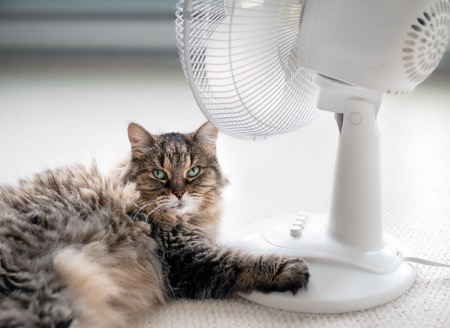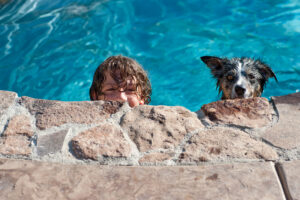As temperatures and humidity rise in Houston, you must ensure your pets stay cool and comfortable. Dehydration and heat stroke can be severe risks for animals, but there are simple steps you can take to keep your furry friends safe and happy on our hottest days of the year. Here are ten hot weather safety tips to help you keep your pets cool this summer.
Pets With Higher Risk for Heatstroke
The first thing to understand is how easily and quickly a pet can get overheated in hot weather, indoors or outdoors. Most animals have sweat glands but do not cool down by sweating like we do. Therefore, it is much easier for a pet to get heatstroke. Pets with higher risks of heatstroke include:
- Puppies and kittens
- Pets with medical issues
- Older pets
- Flat-faced breeds such as pugs, French bulldogs, or Persian cats
What is Heatstroke?
Heatstroke, also known as overheating or heat exhaustion, occurs when a pet’s body temperature rises above 103°F, at which point it can suffer from organ damage, organ failure, and even death. It can only take 5 to 10 minutes for a pet to succumb to heatstroke.
Symptoms of Heatstroke
As temperatures rise, beware of symptoms of overheating, such as:
- Excessive panting
- Excessive drooling
- Erratic pulse
- White or pale gums that seem dry.
- Vomiting or diarrhea
- Confusion, low energy, or sudden lack of coordination
- Rectal temperature of more than 103°F
- Seizures
If you notice any of these symptoms, quickly find access to COOL water and wet your pet down. Give them plenty of fresh, clean, cool water, and call us to see if you should bring them in. Then contact us to find out if you need to bring your pet in for medical attention.
IMPORTANT: NEVER put your pet in an ICE BATH or COLD water. TOO RAPID cooling can shock the heart and cause the blood vessels to constrict, which traps the heat in the body so they cannot cool down.
10 Tips for Hot Weather Safety for Your Pets
1. Provide plenty of fresh water.
One of the most important things you can do to keep your pets cool during the summer is to provide them with plenty of fresh water. Keep their water bowl filled with clean, cool water. You can add ice cubes to help keep it cool. You can also provide multiple water sources throughout your home or yard to make it easy for your pets to stay hydrated.
2. Keep your home cool.
Keeping your home cool is essential for your pets’ comfort during the hot summer. Ensure your air conditioning works appropriately and set it to a comfortable temperature for your pets. Fans can also help to keep your pets cool. You can also provide your pets with cool, shaded areas to rest in, such as a covered porch or a room with tile or hardwood floors.
3. NEVER leave your pet in the car.
Never leave your pet alone in the car on a hot day, even for a brief stop. The temperature in a car can heat up rapidly. For example, on an 85-degree day, even with open windows, your vehicle can reach 98 degrees in just 10 minutes and 114°F in 30 minutes! Below is a chart from the American Meteorological Society:

If you are going to travel this summer, please follow the travel tips covered in our blog: 10 SUMMER TRAVEL TIPS FOR YOUR PETS.
4. Limit outdoor activities during the hottest parts of the day.
To prevent heatstroke, limit outdoor activities during the hottest parts of the day. Instead, take your pets for walks early in the morning or later in the evening when it’s cooler. Taking them out during the cooler parts of the day will also help protect their paws from hot sidewalks or asphalt.
5. Provide shade and shelter.
Ensure your pet has somewhere to go to stay cool. If your pet is outdoors, ensure plenty of trees, umbrellas, or other structures offer shade in your yard. If your pets are indoors, ensure they have a cool area to rest and relax, such as a covered porch or a room with tile or hardwood floors.
6. Treat your pet to a cooling pad.
Cooling pads can help regulate your pet’s body temperature while providing a cushioned place to lie down. Dogs especially like cooling pads, but you can also try them out for cats and exotic pets such as hamsters, guinea pigs, rabbits, chinchillas, squirrels, hedgehogs, etc.
You can put them in your pet’s favorite spot to hang out. People.com provides reviews for the eight best cooling pads for dogs.
7. Are you planning a hike with your dog? Be prepared!
If you plan to hike with your dog, ensure they have a clean bill of health from us first. Good News Network tells a story of a hero saving a dog who collapsed on a trail. The owner had brought water for the dog, but the dog still couldn’t handle the trek. So, it’s essential to ensure they are fit for a hike and bring plenty of water for you and your dog.
8. Keep your pet groomed.
Some think shaving their pets in the summer will help their pet stay cooler. However, pets’ coats have several layers essential to their comfort in the heat. Shaving removes your pet’s natural cooling system and can lead to discomfort, overheating, and other dangers like sunburn or skin cancer. However, grooming your pet will help them regulate their body temperature better.
9. Keep high-risk pets inside on hot days.
As we mentioned above, some pets are more at risk for heatstroke – elderly, obese, or have medical issues, as well as flat-faced breeds. These pets should be kept inside an air-conditioned home on hot days except for taking them outside briefly for bathroom breaks.
10. Be watchful for signs your pet is getting too hot.
Waiting for signs of heatstroke before acting is waiting too long. If your dog looks uncomfortable or panting more than usual, it is time to bring them inside to cool down. If you see a cat panting in hot weather, realize panting is not common in cats, and you should get them inside and cool them down. There are other causes for cats panting, so if you are unsure why your cat is panting, please contact us.

If you have an exotic pet, it is critical you know the temperature limits for your pet. For example, rabbits, chinchillas, and Guinea pigs are at risk when the temperature goes over 80°. Ferrets are at risk at temperatures over 95°. Please give us a call if you have any questions about the temperature tolerances for your pet.
Final Words on Hot Weather Safety for Your Pets
Remember that your furry loved ones can’t tell you when they are too hot. They count on you to protect them from the heat and ensure they have enough fresh water to stay hydrated. So, please follow the above tips, play it safe, and keep your pets cool this summer!
Your Friendly Team
Braescroft Animal Clinic





